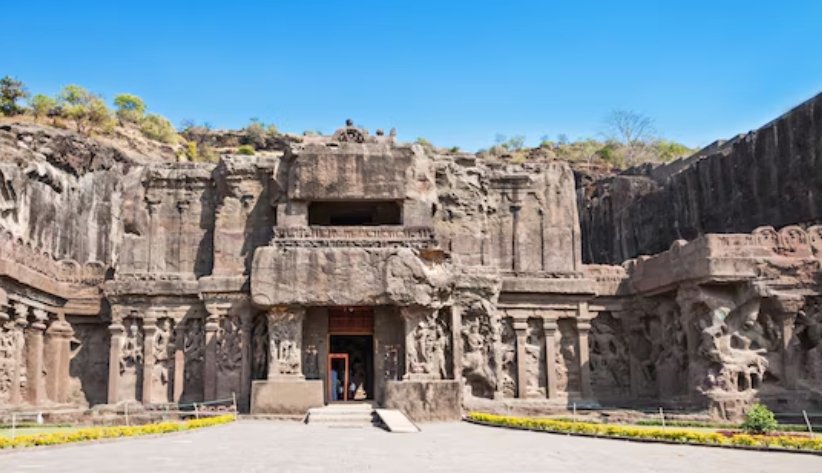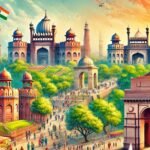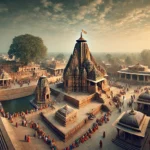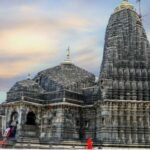The remarkable Ajanta Caves in Maharashtra, India are a collection of rock-cut temples and monasteries that bear witness to the artistic prowess, religious devotion, and architectural inventiveness of ancient Indians. One of the most amazing archaeological sites in the world, these caverns are tucked away in the thick forest of the Sahyadri hills and provide a fascinating window into a different time period. This blog post delves deeply into the Ajanta Caves, detailing their artistic genius, historical significance, architectural elements, and lasting legacy.
Table of Contents
Overview of History: A Peer Into the Past
Thirty Buddhist cave monuments carved out of rock that span from the second century BCE to roughly 480 CE are known as the Ajanta Caves. About 100 kilometres from the Maharashtra city of Aurangabad are the caves, which are close to the town of Ajanta.
These caves were coincidentally discovered in the early 1800s by a hunting group from Britain under the leadership of John Smith. The passage of time and thick vegetation had hidden the caves, causing them to be lost to the pages of history. The two main periods during which the caverns were formed are as follows. In the first stage, caverns were built between the second century BCE and the first century CE, mostly for monastic and meditational purposes.
The second phase, which spans the 5th and 6th century CE, is known for its thriving artistic and architectural growth and is associated with the Vakataka dynasty’s control and support of Buddhism.
Masterworks of Art: A Canvas of Diverse Cultural History
The beautiful murals found in the Ajanta Caves are widely recognised as masterpieces of Buddhist art. The caverns’ walls and ceilings are covered in paintings that portray a variety of subjects, such as Buddhist jataka stories, the life of the Buddha, and several Bodhisattvas.
1. Jataka Tales
These are accounts of the Buddha’s past incarnations. His previous incarnations are shown in the paintings, which serve as teaching tools for moral and intellectual ideas. The “Vessantara Jataka,” which describes the Buddha’s existence as Prince Vessantara, renowned for his kindness, is one of the most well-known jataka narratives recounted.
2. Life of the Buddha
Detailed murals in multiple caves depict significant moments in the life of Siddhartha Gautama, the future Buddha. Scenes like his birth, his enlightenment beneath the Bodhi tree, and his first lecture are depicted clearly, demonstrating the authors’ narrative brilliance and creative dexterity.
3. Deities and Bodhisattvas
Various Bodhisattvas, or enlightened beings who have decided to stay in the cycle of rebirth in order to aid others in becoming enlightened, are also depicted in the paintings. The elaborate depictions of these celestial beings mirror the abundant symbolism found in Mahayana Buddhism.
The Ajanta Cave paintings utilise a wet plaster technique in conjunction with natural pigments as its creative medium. The paints were put by the artists onto wet plaster, enabling the colours to combine and produce a striking and long-lasting effect. The figures are given depth and realism through the use of detailed line work and shading, which also produces a dynamic interplay of light and shadow.
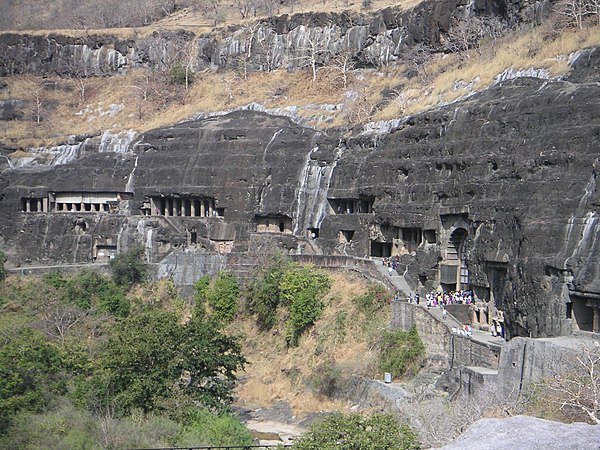
The Caves' Architecture and Structure
In addition to being a treasure mine of artwork, the Ajanta Caves are a marvel of prehistoric rock-cut architecture. The two main classifications of the caves are chaityas (prayer halls) and vihars (monastic cells).
1. Vihars
Monks resided and practiced meditation at these monasteries. The interiors of the vihars are simple and roomy, frequently consisting of a central hall encircled by individual monks’ cells. The practical architectural plan allows for both group life and meditation.
2. Chaityas
These prayer halls are distinguished by their expansive, airy layouts, frequently featuring a stupa—a structure resembling a mound—at the end of the hall. The rich interiors and fine carvings of the chaityas set them apart and are meant for congregational devotion. The primary point of worship is the centre stupa, which is a representation of the Buddha.
The caves’ construction required careful planning and execution. The granite was carved by the artists using hammers and chisels, which needed a great deal of coordination and talent. The Ajanta hills’ volcanic basalt rock is where the caverns were carved out of, and the structural soundness of these rock-cut temples is a testament to the architects’ sophisticated knowledge of both engineering and design.
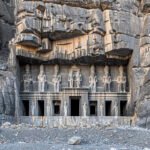
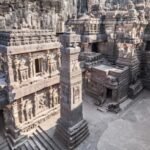
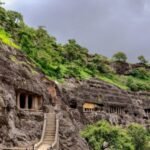
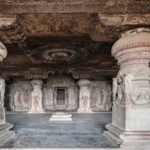
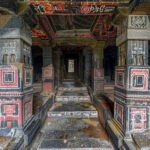
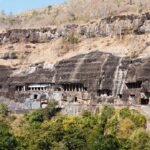
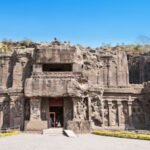
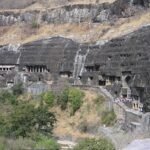
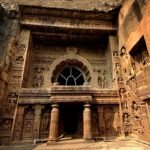

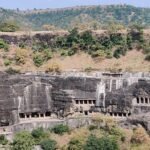
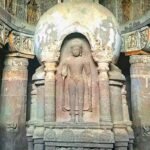
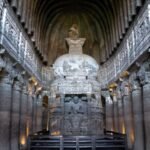
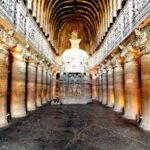
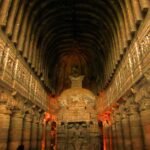
Difficulties with Preservation: Preserving the Legacy
There are numerous obstacles in the way of maintaining the Ajanta Caves. The murals and architecture within the caverns are susceptible to natural elements including dampness, temperature changes, and biological growth. In addition, there are threats to the site’s conservation from the increase in visitors and human activity.
Efforts to preserve and protect the Ajanta Caves include
1. Restoration Projects
To preserve and mend the paintings and the caverns’ structural components, a number of restoration projects have been started. The Archaeological Survey of India (ASI) and other conservation organisations carry out these work using methods that preserve the original artistry while minimising additional deterioration.
2. Environmental Controls
Techniques like regulating temperature and humidity are used to lessen the effects of environmental elements. To protect the paintings, this also entails using dehumidifiers and climate-controlled spaces.
3. Tourism Management
In order to keep the site intact, controlling the number of visitors is essential. To reduce the negative effects of tourism, rules and regulations are put in place. Examples include limiting the number of visitors at any given time and informing people about the importance of the site.
Cultural and Historical Significance
The Ajanta Caves are of great historical and cultural importance. They offer insightful perspectives on the social, cultural, and religious life of ancient India. The caverns show how Buddhism spread over centuries and influenced art and architecture, as well as how Buddhist thinking and practice changed over that time.
In addition, the Ajanta Caves document the cultural exchanges that took place along the old trade routes and the patronage of the Vakataka dynasty. The creative mediums and methods employed in the caverns provide insight into the interactions and ideas that flow between various cultures and geographical areas.
Global Recognition and Legacy
The Ajanta Caves’ 1983 UNESCO World Heritage Site designation is proof of their widespread acceptance. This recognition emphasises how valuable they are to everyone and how crucial it is to protect them for coming generations. Additionally, the designation increases public awareness of the value of the site and makes it easier for nations to collaborate on conservation initiatives.
Around the world, scholars, artists, and tourists are still influenced by the Ajanta Caves. They serve as a testament to the ongoing legacy of a society that valued creativity and spirituality, standing as a beacon of ancient Indian artistic and architectural prowess.
My Thought 💭
The Ajanta Caves are a magnificent example of ancient India’s creative and architectural prowess. Through their spectacular rock-cut buildings and elaborate murals, they provide a unique window into the spiritual and cultural life of a bygone era. The Ajanta Caves are a location of great historical and cultural significance that inspires and invites thought in modern audiences in addition to commemorating the accomplishments of their founders.
Because of the preservation efforts that protect their significance and beauty, the Ajanta Caves’ legacy lives on. We are reminded of the age-old human search for purpose, beauty, and spiritual enlightenment as we stand in awe of the creativity and inventiveness of these ancient works. The Ajanta Caves are still a magnificent illustration of how architecture and art can withstand the test of time and enthral and inspire future generations.
